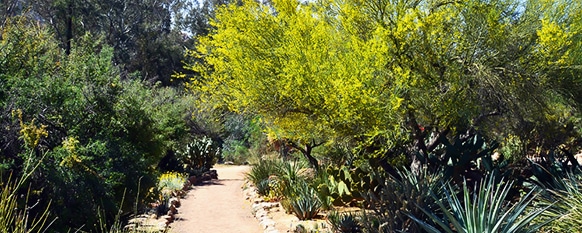When it comes to trees that thrive in a desert garden and landscape, homeowners have a wealth of choices. Whether you’re seeking a tree tolerating drought, sun, heat, or those that flower or are suitable for a small yard, there’s a tree fitting your needs.
Continue reading to learn about some of the most popular varieties.
We recommend that you check out some of our flower guides. Learn how to grow siberian irises, which produce beautiful, vibrant blooms.
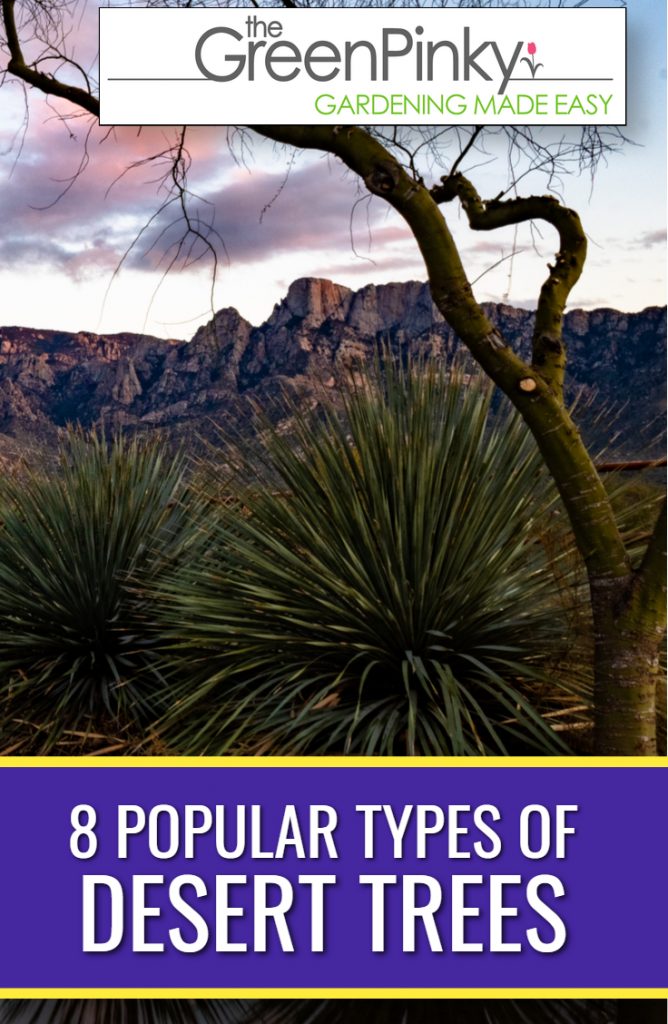
Chaste Tree (Vitex agnus-castus)
Although native to southern regions of the Mediterranean, chaste trees make a hardy addition to a desert garden like southern Arizona.
It’s hardy growing in USDA zones 6 through 9. In the coolest portion of its hardiness range, it may die down to ground level in the winter but will resprout in spring. However, it grows best in an area with warmer winters.
Provided preferred conditions, chaste trees thrive in the heat, sun, and dry and arid conditions that a desert landscape offers. It has an average lifespan of 50 to 150 years.
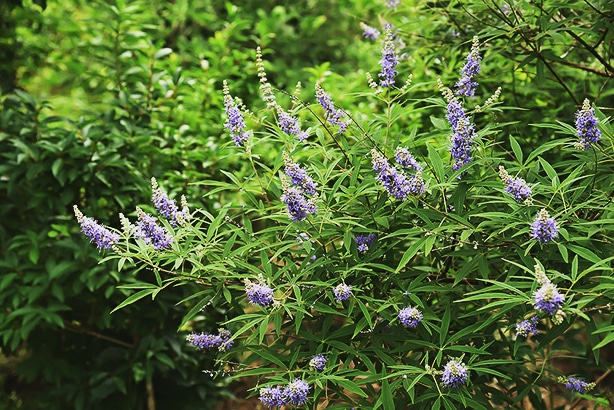
They have a vase-shaped, shrub-like nature and form multiple trunks. With pruning, it can be shaped to be 20 feet tall and wide at maturity.
They are deciduous in the winter. However, in the spring, the canopy fills with a 6-inch lance-shaped, grayish-green foliage that is fragrant. In summer, 12-inch long, upright panicles fill with fragrant purple flowers that make a beautiful sight rising above the canopy.
For the best performance and growth, grow it in a site situated in full sun or partial shade. Although it prefers fertile soil that drains well, it’s also tolerant to drier and less fertile soils when provided sufficient water. Once established, it grows best with regular and deep water applications. It is moderately drought-tolerant. That being said, make sure to water weekly during its first year of growth.
Chilean Mesquite (Prosopis chilensis)
Native to South America and the Southwest, the Chilean mesquite makes an attractive and hardy addition to a desert landscape, xeriscapes, and rock gardens. Hardy in USDA zones 8 through 11, these heat-lovers and drought-tolerant trees thrive in areas like Texas and Arizona.
Chilean mesquites are semi-evergreen and develop an open and spreading canopy filled with airy green, fern-like leaves. This fast-growing tree grows to a mature height of 30 feet tall and wide and can live 50 to 150 years.
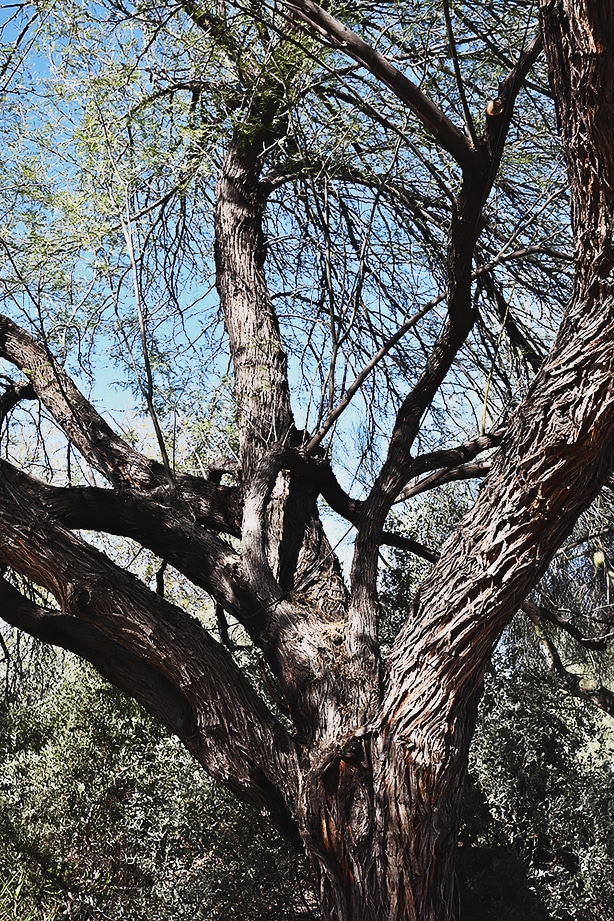
The grey bark is fissured, and depending on the variety, it may either be thornless or contain thorns. In spring, inconspicuous greenish-yellow flowers bloom. Once the flowers fade, they give way to long brown seed pods that attract birds. The Chilean mesquite also works well planted in groups where the airy canopy filters the harsh sun and reduces heat and glare.
Chilean mesquites grow well in fast-draining soils that have a sandy texture and are dry. They also grow best when they are planted in a site that receives full sun.
During their first year of growth, water deeply weekly. Thereafter, the it only requires occasional irrigation. However, if summer conditions are sweltering and dry, it may need more frequent water applications.
Desert Willow (Chilopsis linearis)
Native to California, Texas, Arizona, and New Mexico, desert willow is an attractive tree that is hardy in USDA zones 8 and 9.
It earns its common name due to it resemblance to true willow trees. It is tolerant of the heat and arid conditions found in a desert region.
It has an average lifespan of 40 years or longer.
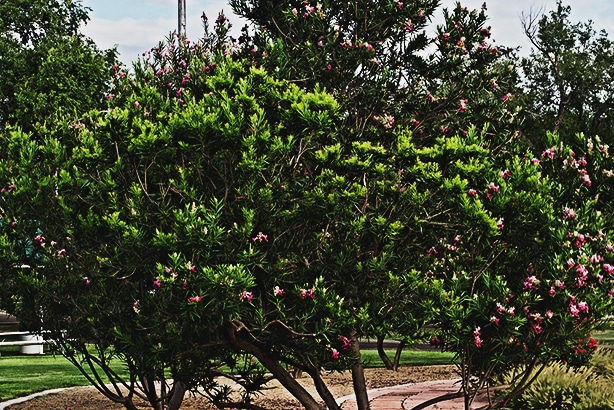
The desert willow has a deciduous and fast-growing habit. They produce a single trunk that often has a twisting or leaning habit and open, low branches. The willow-like foliage is light green and grows anywhere from 4 to 12 inches long. Fragrant and showy flowers start blooming in late spring and smell like violets. Blooms are funnel-shaped and range in colors of purple to dark pink with white or yellow streaked throats.
In autumn, once the flowers fade, long and slender seed pods form. Various birds and pollinators are attracted to the flowers and seed pods. Desert willow averages around 15 to 25 feet tall and 10 to 20 feet wide, making it suitable for a small yard or landscape.
They thrive in various well-drained soils, although limestone soils are preferred. They grow best when planted in full sun. Excessive water leads to weaker growth, a reduction in flowers, and problems with rot. Allow the soil to dry out between water applications to encourage more blooms.
Desert willow makes a beautiful addition to rock gardens, xeriscapes, pollinator gardens, or a sunny garden.
Texas Mountain Laurel (Sophora secundiflora)
The Texas mountain laurel is native to Texas and New Mexico that is hardy in USDA zones 7 through 10.
This tough native tree stands up to sun, wind, heat, and arid conditions. Sophora secundiflora makes an attractive addition to a small yard, patio, or landscape. Texas mountain laurel is one of the many trees that grow well in an arid climate.
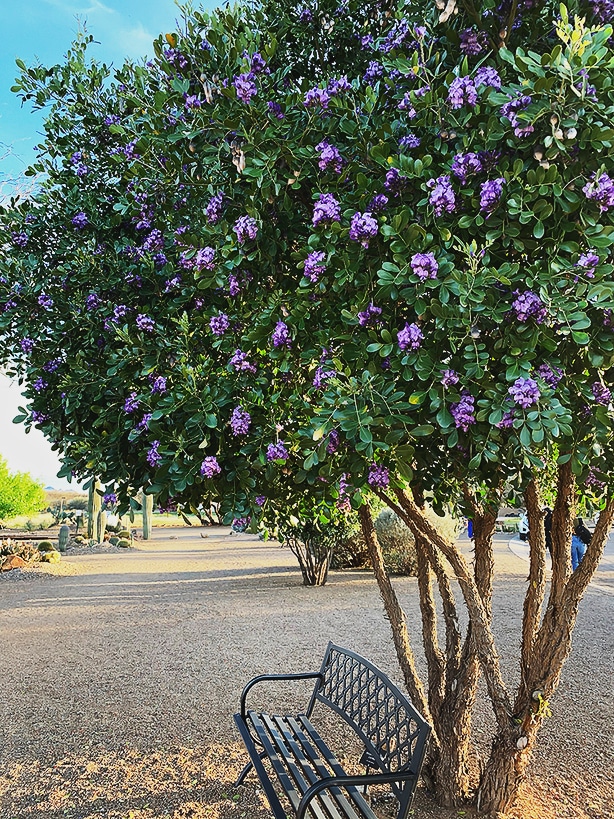
Sophora secundiflora has an evergreen habit and it typically grow several trunks. It grows to be about 15 to 20 feet tall and about 10 feet wide.
This tree develops a symmetrical canopy filled with glossy dark green foliage that is leathery, making it quite showy. In spring, purple-bluish flowers bloom that smell like grape Kool-Aid and fill the landscape with their fragrance. The showy flowers form in drooping clusters that are around 7 inches long and attract beneficial pollinators.
Like many plants growing in rocky soil conditions, Texas mountain laurel is slow-growing. After its flowers fade, gray seed pods form that have a felt-like texture. As the seed pods age, they change to brown and open to reveal red seeds that are toxic.
Texas mountain laurels grow best in a site situated in full sun to partial shade. Grow it in well-drained soil that is rocky, sandy, loamy, or dry. Just make sure that the soil drains well to prevent rot problems. Once established, it is very tolerant to drought. While it is still establishing itself, it will benefit from a bit of shade and regular watering. This is especially true if your region is incredibly hot during summer.
Texas Ebony (Ebenopsis ebano)
Native to Texas, the Texas ebony is a true desert tree thriving in the heat found in USDA zones 10 and 11.
Although extremely tolerant to drought, its roots are also resistant to root rot. The roots can be invasive, so make sure not to plant it close to your house. The Texas ebony is a slow grower and has a lifespan of 50 to 150 years.
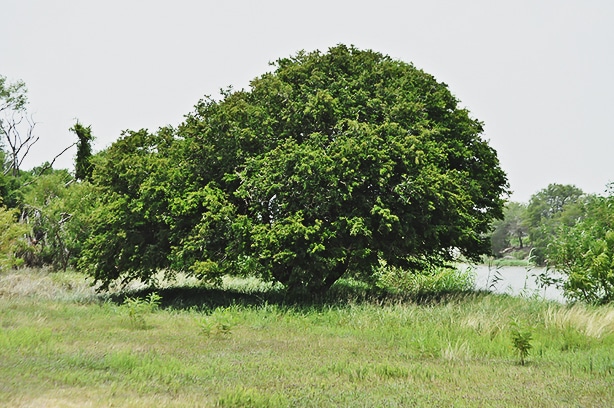
Texas ebonies usually produce multiple trunks, developing rough brown bark. Although the branches resist breakage, they are covered in thorns. They develop a vase shape, with the canopy filling with pinnately compound green foliage. Once mature, the dense foliage makes Texas ebony an excellent shade tree.
In summer, showy yellow flowers bloom that are fragrant and attract beneficial pollinators to the landscape. Once the flowers fade, they give way to 6- to 12-inch long seed pods. The Texas ebony matures to a size of about 30 to 40 feet tall and wide.
As a tree with a high tolerance to dry, drought conditions, it doesn’t require much water to thrive. Make sure to plant it in well-drained soil. Additionally, it grows well in either acidic or alkaline soil with good drainage. Plant Texas ebony in a location that receives full sun. You can grow it as a dense shade tree, specimen, in a native or pollinator garden or along a buffer strip. Due to its large size, it’s best suited for a large landscape.
Sweet Acacia Tree (Acacia farnesiana)
Sweet acacias’ small size and great looks make them perfect additions to small yards. They thrive in regions with consistently hot temperatures found in USDA zones 9 through 11. They aren’t tolerant of cold conditions.
They make beautiful flowering specimens in a smaller landscape, used in wildlife gardens, or as a barrier plant due to its thorny nature. When considering where to plant the acacia in the landscape, consider the thorns and situate in a location away from foot traffic.
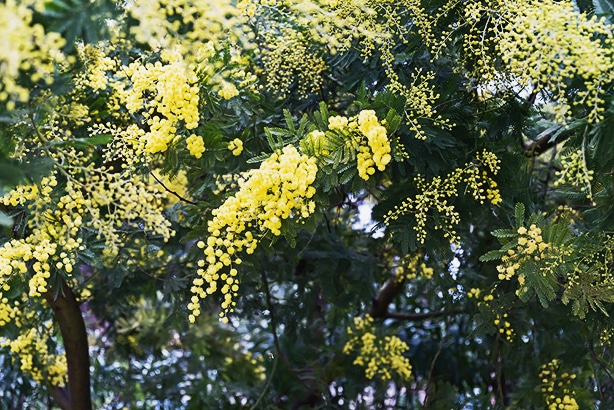
Sweet acacias are semi-evergreen and develop with a spreading and irregularly rounded canopy. The canopy fills with green feathery foliage and the grayish-green branches are lined in thorns at the leaves’ base. Sweet acacias mature at around 25 feet tall and wide.
The tree has fast growth, growing around 2 feet yearly. It can also be pruned into a large bush. In late winter or early spring, they fill with fragrant yellow flowers that are shaped like puffballs. The yellow flowers last long into the season, as with each new flush of growth, another round of flowers bloom.
Sweet acacias grow best planted in a landscape receiving full sun, although they tolerate partial shade. The acacia performs well in a variety of well-drained soils and is quite drought-tolerant once established in the landscape. While the sweet acacia is establishing itself, water several times weekly. Thereafter, watering every few weeks is sufficient.
Sweet acacias typically have a lifespan of around 50 years. Consider the tree’s weak wood when selecting a landscape location.
Blue Palo Verde (Parkinsonia florida)
Native to the Sonoran Desert regions of Arizona and California, blue Palo Verde are able to stand up to sun and heat. They are hardy growing throughout USDA zones 8 through 11 and aren’t tolerant of extremely cold winters.
This small shrub-like tree is an excellent addition to a garden where conditions are extremely dry. It works well used as a screen or in wildlife or pollinator gardens, as the flowers and seeds attract birds and beneficial pollinators. Blue Palo Verde has a typical lifespan of 50 to 150 years.
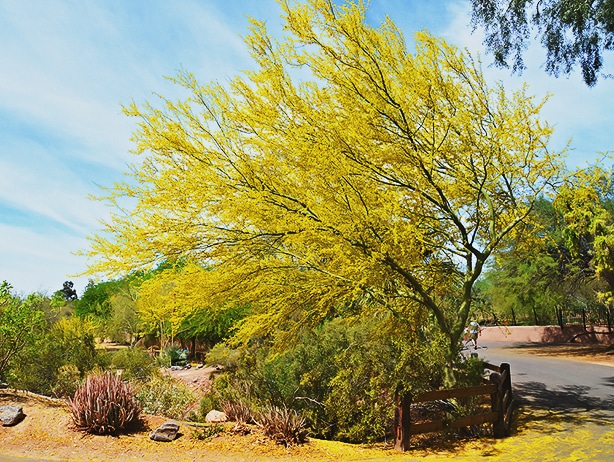
The Blue Palo Verde can be pruned into shrubs and grow around 20 feet tall and 15 to 25 feet wide. It forms a rounded and low canopy.
The graceful tree develops a large bluish-green trunk, with bluish-green pinnately compound leaves that are deciduous. In spring, blue Palo Verde bursts into bloom with bright yellow flowers. The yellow flowers form into clusters and are quite showy. Once the flowers fade, 3-inch long seed pods form. The yellow flowers last long into the summer season.
For the best results, grow this species of Palo Verde in full sun. It prefers a site with well-drained soil that is loamy or sandy and has a pH that is neutral or slightly alkaline. Although tolerant to drought once established, water it weekly until it establishes itself in the landscape. When you are considering where to plant it, take into consideration that it has thorns.
Palo Verde ‘Desert Museum’
Palo Verde ‘Desert Museum’ is a hybrid resulting from a three-way cross between Palo Verde Parkinsonia florida, Parkinsonia aculeata, and Parkinsonia microphyllum. Combining the best characteristics from the three resulted in the hybrid Desert Museum. With the parents native to the Chihuahan and Sonoran Deserts, Desert Museum inherited their tolerance to heat, sun, drought, and dry conditions.
The hybrid Palo Verde is hardy in USDA zones 8 – 9 and isn’t tolerant of extremely cold winters.
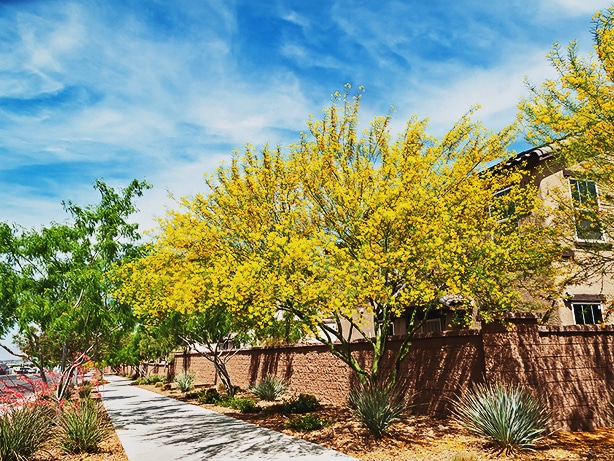
Desert Museum trees have a spreading habit and form into a vase-like shape with low hanging branches. The fast-growing tree grows around 15 to 20 feet tall and at least 20 feet wide at maturity. Thornless green branches have an upright habit. They are covered in the bipinnately compound, light green foliage that is deciduous.
In spring, showy and fragrant yellow flowers form in long clusters, filling the canopy with beautiful color. The flowers attract beneficial pollinators. Given enough water, Desert Museum continues blooming through summer. In fact, of all Palo Verde species, the Desert Museum flowers the longest. Long brown seed pods follow the spent flowers in fall.
For the best growth, situate Desert Museum in a site located in full sun. Grow it in well-drained loamy or sandy soil. Although tolerant to drought once established, water several times weekly for the first few months and also if weather conditions are extremely hot and dry. Thereafter and depending on the weather, you can water every week or so. Due to its colorful flowers, small size, and hardiness, Desert Museum makes addition to a desert garden, small yard, or landscape. It has an expected average lifespan of 40 to 150 years.

